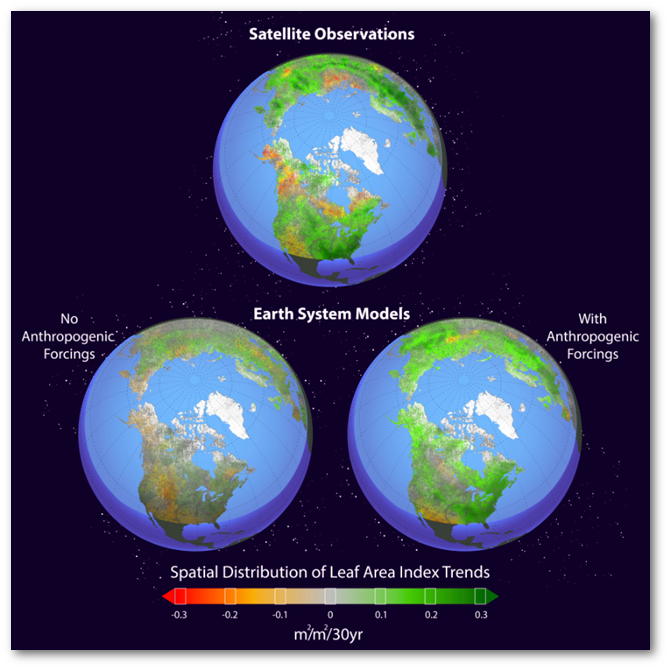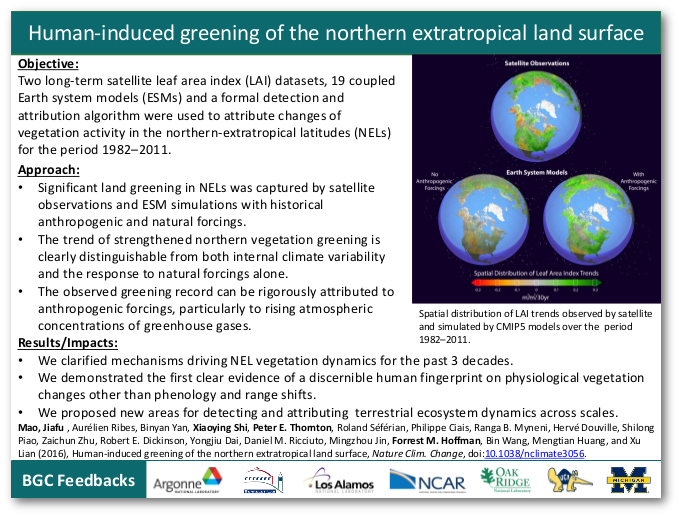Research Highlights
Human-induced greening of the northern extratropical land surface
October 1, 2016
This study examines Leaf Area Index (LAI, area of leaves per area of ground) during the growing season (April–October) over the NEL (30°–75°N). Previous work assessing modeled and observed LAI has focused on timing of seasonal growth, interannual variability, and multiyear trends. Earlier studies showed that spatiotemporal changes in LAI were related to variation in climate drivers (mainly temperature and precipitation). This study adds to an increasing body of evidence that NEL has experienced an enhancement of vegetation activity, as reflected by increased trends in vegetation indices, aboveground vegetation biomass, and terrestrial carbon fluxes during the satellite era. Our analysis goes beyond previous studies by using formal detection and attribution methods to establish that the trend of increased northern vegetation greening is clearly distinguishable from both internal climate variability and the response to natural forcings alone. It can be rigorously attributed, with high statistical confidence, to anthropogenic forcings, particularly to rising atmospheric concentrations of greenhouse gases.
Impact
Our work demonstrates the first clear evidence of a discernible human fingerprint on NEL physiological vegetation changes, and propose new investigations which could use detection and attribution methods to study broad-scale terrestrial ecosystem dynamics.
Summary of Results
Significant land greening in the NEL has been documented through satellite observations during the past three decades. This enhanced vegetation growth has broad implications for surface energy, water and carbon budgets, and ecosystem services across multiple scales. Discernable human impacts on the Earth’s climate system have been revealed by using statistical frameworks of detection and attribution. These impacts, however, were not previously identified on the NEL greening signal, due to the lack of long-term observational records, possible bias of satellite data, different algorithms used to calculate vegetation greenness, and the lack of suitable simulations from coupled Earth system models (ESMs). Here we have overcome these challenges in order to attribute recent changes in NEL vegetation activity. We used two 30-year-long remote-sensing-based LAI datasets, simulations from 19 coupled ESMs with interactive vegetation, and a formal detection and attribution algorithm. Our findings reveal that the observed greening record is consistent with an assumption of anthropogenic forcings, where greenhouse gases play a dominant role, but is not consistent with simulations that include only natural forcings and internal climate variability. Given the strong evidence provided here of historical human-induced greening in the northern extratropics, society should consider both intended and unintended consequences of its interactions with terrestrial ecosystems and the climate system.
Objective
Two long-term satellite leaf area index (LAI) datasets, 19 coupled Earth system models (ESMs) and a formal detection and attribution algorithm were used to attribute changes of vegetation activity in the northern-extratropical latitudes (NELs) for the period 1982–2011.
Approach
- Significant land greening in NELs was captured by satellite observations and ESM simulations with historical anthropogenic and natural forcings.
- The trend of strengthened northern vegetation greening is clearly distinguishable from both internal climate variability and the response to natural forcings alone.
- The observed greening record can be rigorously attributed to anthropogenic forcings, particularly to rising atmospheric concentrations of greenhouse gases.
 |
Spatial distribution of LAI trends observed by satellite and simulated by CMIP5 models over the period 1982–2011. |
Results/Impacts
- We clarified mechanisms driving NEL vegetation dynamics for the past 3 decades.
- We demonstrated the first clear evidence of a discernible human fingerprint on physiological vegetation changes other than phenology and range shifts.
- We proposed new areas for detecting and attributing terrestrial ecosystem dynamics across scales.
Mao, Jiafu, Aurélien Ribes, Binyan Yan, Xiaoying Shi, Peter E. Thornton, Roland Séférian, Philippe Ciais, Ranga B. Myneni, Hervé Douville, Shilong Piao, Zaichun Zhu, Robert E. Dickinson, Yongjiu Dai, Daniel M. Ricciuto, Mingzhou Jin, Forrest M. Hoffman, Bin Wang, Mengtian Huang, and Xu Lian. October 1, 2016. “Human-induced Greening of the Northern Extratropical Land Surface.” Nature Clim. Change, 6(10):959–963. doi:10.1038/nclimate3056.
